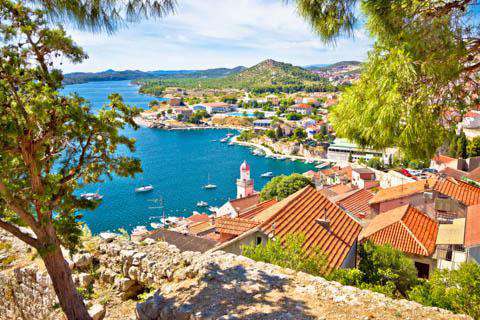Traveling in Sibenik
 Sibenik, Croatia
Sibenik, Croatia
Sibenik is a city on the Adriatic coast of Croatia. It's known as a gateway to the Kornati Islands. The 15th-century stone Cathedral of St. James is decorated with 71 sculpted faces. Nearby, the Sibenik City Museum, in the 14th-century Prince's Palace, has exhibits ranging from prehistory to the present. The white stone St. Michael's Fortress has an open-air theater, with views of Sibenik Bay and neighboring islands. The city's magnificent medieval heart, gleaming white against the placid waters of the bay is enough to excite any traveler, and you won't be disappointed with your trip here. The stone labyrinth of steep backstreets and alleys are a joy to explore. Sibenik is also an important access point for Krka National Park and the Kornati Islands.
Neighborhoods & Around
Historic Center
The Historic Center of Sibenik is of most interest to visitors. It is here where many of the sights and attractions are located. The city most renowned for many churches in the historic center, they are really on just about every corner. Most of them have been repurposed as museums, galleries and other public spaces. Historic city center is built in stone, with extremely tight and winding streets with many staircases and arched passages. The rich heritage is best visible while navigating small plazas and numerous historic monuments of the city.
Marina Mandalina
The Marina Mandalina neighborhood is located just south of the city center of Sibenik. Mandalina is a perfect starting point for sailing Croatia, whether you choose to sail north or south. From Marina Mandalina you are within close reach of the islands of Solta, Hvar, Brac and Vis, all lying in close proximity to Split. North of Marina Mandalina is the Kornati archipelago, which is known by true sailors as a dream sailing location. Here you will find plenty of natural harbors, cozy bays and uncrowded beaches.
Baldekin
Baldekin is the largest neighborhood in Sibenik, and according to some, the most beautiful part of the city. Here you will find many tall buildings and just about anything the modern tourist could want. It is a laid back, easy going area and people here are sociable and friendly.


 Sibenik stands out for its impressive museums and notable landmarks. Despite being skipped by many international tourists, the town has a number of historical landmarks such as Sibenik Cathedral, St. Michael's Fortress, and the fascinating the Dalmatian Ethno Village.
Sibenik stands out for its impressive museums and notable landmarks. Despite being skipped by many international tourists, the town has a number of historical landmarks such as Sibenik Cathedral, St. Michael's Fortress, and the fascinating the Dalmatian Ethno Village. Visitors to Sibenik often come to enjoy a laid-back day at the beach. The beaches are less crowded than those in the more popular nearby cities, but they are gaining popularity. In town, Banj Beach is a pebbly beach that is easy to access. Nearby Jadrija Beach is considered to be one of the most photogenic in the area and St. Nicholas Beach is one of the more remote.
Visitors to Sibenik often come to enjoy a laid-back day at the beach. The beaches are less crowded than those in the more popular nearby cities, but they are gaining popularity. In town, Banj Beach is a pebbly beach that is easy to access. Nearby Jadrija Beach is considered to be one of the most photogenic in the area and St. Nicholas Beach is one of the more remote. The historic old town is a popular destination for many visitors. The charming old town is car-free and filled with quaint streets and lovely cafes.
The historic old town is a popular destination for many visitors. The charming old town is car-free and filled with quaint streets and lovely cafes. Budget Your Trip is all about finding out how much everything costs so that you can travel cheaper and longer. Created by avid travelers Laurie and Bryan, our goal is to help you plan your next trip on the right budget. With average daily travel costs that are calculated from the budgets of real travelers, plus an analysis of hotel and tour prices, you can find out how much money you need to plan your next adventure. We also have plenty of travel advice, accommodation reviews, and activity suggestions.
Budget Your Trip is all about finding out how much everything costs so that you can travel cheaper and longer. Created by avid travelers Laurie and Bryan, our goal is to help you plan your next trip on the right budget. With average daily travel costs that are calculated from the budgets of real travelers, plus an analysis of hotel and tour prices, you can find out how much money you need to plan your next adventure. We also have plenty of travel advice, accommodation reviews, and activity suggestions.